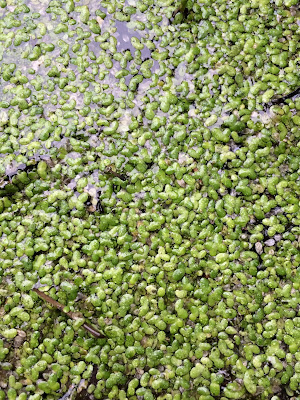Date: October 2nd, 2016
Time: 12:11PM - 1:19PM
Weather Conditions: 55 degrees Fahrenheit, overcast, heavy misting
Location: The Dell at Mount Auburn Cemetery - Watertown and Cambridge, MA
I arrived at the Dell at around noon on a cold and wet day. The water showed no signs of movement. I startled a few small brown frogs into the water as I walked by, but one perched on a log jutting out of the water for my entire stay. I set up my transect along the edge of the water and carefully took in my surroundings. Behind me were large rhododendron bushes and deciduous trees (like a sugar maple), and on the other side of the water was a steep bank covered with conifers. The Dell was covered with so much duckweed that you could not see the surface of the water, so the whole area was coated with a vibrant green.
Transect and pH Readings:
The ground was almost too wet for me to stand on. I could not walk to the water's edge because my shoes would quickly sink into the mud. There was a large bush with unripe fruit, and a group of tall plants with leaves reminiscent of elephant ears (the largest leaf was 15 inches). They had thick stalks and I spotted an unusual seed pod at the end of one. It was about 2.5" and was filled with brown kernels that were about 3/4". The kernels were attached to a white stalk in the center of the pod. I popped open a few of the kernels (the outside felt like a thin piece of rubber), and there was a clear, gelatin-like substance surrounding what I assume was the green seed. The kernels floated when I put them in the water.
I kept moving along the shore and encountered at least three different species of fern, as well as burdock (which had gone to seed) and a few wildflowers still in bloom. The back of one of the ferns was covered with spores. Most of these plants were a few feet away from the water's edge, perhaps because the soil is too wet near the edge. Duckweed covered part of the shore as well as the surface of the water. I think this may be from the water level receding, but that is just a guess. There were many broken/rotting branches on shore and in the shallowest parts of the water.
I did not have a thermometer with me, so I stuck my hand into the water. It was cooler than the air around me, and when I pulled my hand out it was coated with duckweed. I bet duckweed spreads to other bodies of water by hitching a ride on animals. The water was cooler than the surrounding air because of water's high specific heat. Water is slow to heat up because it takes a great amount of energy to break hydrogen bonds and raise the temperature by one degree. I measured the pH of the water in three different locations along my transect. Each turned a pale yellow (possibly a reading of 6 or 7?). I also tested rain water that had accumulated on a nearby boulder, and the reading was more orange than the others (a 5 or 6, maybe). Pure water at a pH of 7 has ten times as many hydrogen ions as this body of water, if the pH is considered to be 6. The strip marked "R" is the one used to test rainwater:









No comments:
Post a Comment